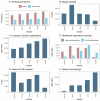Equity impact of minimum unit pricing of alcohol on household health and finances among rich and poor drinkers in South Africa
- PMID: 34992078
- PMCID: PMC8739056
- DOI: 10.1136/bmjgh-2021-007824
Equity impact of minimum unit pricing of alcohol on household health and finances among rich and poor drinkers in South Africa
Abstract
Introduction: South Africa experiences significant levels of alcohol-related harm. Recent research suggests minimum unit pricing (MUP) for alcohol would be an effective policy, but high levels of income inequality raise concerns about equity impacts. This paper quantifies the equity impact of MUP on household health and finances in rich and poor drinkers in South Africa.
Methods: We draw from extended cost-effectiveness analysis (ECEA) methods and an epidemiological policy appraisal model of MUP for South Africa to simulate the equity impact of a ZAR 10 MUP over a 20-year time horizon. We estimate the impact across wealth quintiles on: (i) alcohol consumption and expenditures; (ii) mortality; (iii) government healthcare cost savings; (iv) reductions in cases of catastrophic health expenditures (CHE) and household savings linked to reduced health-related workplace absence.
Results: We estimate MUP would reduce consumption more among the poorest than the richest drinkers. Expenditure would increase by ZAR 353 000 million (1 US$=13.2 ZAR), the poorest contributing 13% and the richest 28% of the increase, although this remains regressive compared with mean income. Of the 22 600 deaths averted, 56% accrue to the bottom two quintiles; government healthcare cost savings would be substantial (ZAR 3.9 billion). Cases of CHE averted would be 564 700, 46% among the poorest two quintiles. Indirect cost savings amount to ZAR 51.1 billion.
Conclusions: A MUP policy in South Africa has the potential to reduce harm and health inequality. Fiscal policies for population health require structured policy appraisal, accounting for the totality of effects using mathematical models in association with ECEA methodology.
Keywords: epidemiology; health economics; health policy; mathematical modelling; public health.
© Author(s) (or their employer(s)) 2022. Re-use permitted under CC BY. Published by BMJ.
Conflict of interest statement
Competing interests: None declared.
Figures



Similar articles
-
Effects of minimum unit pricing for alcohol in South Africa across different drinker groups and wealth quintiles: a modelling study.BMJ Open. 2021 Aug 9;11(8):e052879. doi: 10.1136/bmjopen-2021-052879. BMJ Open. 2021. PMID: 34373316 Free PMC article.
-
Estimated Effects of Different Alcohol Taxation and Price Policies on Health Inequalities: A Mathematical Modelling Study.PLoS Med. 2016 Feb 23;13(2):e1001963. doi: 10.1371/journal.pmed.1001963. eCollection 2016 Feb. PLoS Med. 2016. PMID: 26905063 Free PMC article.
-
The distributional impact of taxing sugar-sweetened beverages: findings from an extended cost-effectiveness analysis in South Africa.BMJ Glob Health. 2019 Aug 21;4(4):e001317. doi: 10.1136/bmjgh-2018-001317. eCollection 2019. BMJ Glob Health. 2019. PMID: 31543983 Free PMC article.
-
Impact of minimum unit pricing on alcohol-related hospital outcomes: systematic review.BMJ Open. 2023 Feb 3;13(2):e065220. doi: 10.1136/bmjopen-2022-065220. BMJ Open. 2023. PMID: 36737089 Free PMC article.
-
Potential effects of minimum unit pricing at local authority level on alcohol-attributed harms in North West and North East England: a modelling study.Southampton (UK): NIHR Journals Library; 2021 Mar. Southampton (UK): NIHR Journals Library; 2021 Mar. PMID: 33764725 Free Books & Documents. Review.
Cited by
-
Is alcohol outlet availability associated with binge drinking in Canadian young adults? Findings from British Columbia and Quebec.Can J Public Health. 2024 Aug;115(4):567-576. doi: 10.17269/s41997-024-00905-6. Epub 2024 Jun 25. Can J Public Health. 2024. PMID: 38918359 Free PMC article.
-
Public and professional stakeholders' perceptions of alcohol advertising and availability policies: A qualitative study.Drug Alcohol Rev. 2025 Jan;44(1):104-118. doi: 10.1111/dar.13972. Epub 2024 Oct 28. Drug Alcohol Rev. 2025. PMID: 39468768 Free PMC article.
-
A Systematic Review of Methods for Estimating Productivity Losses due to Illness or Caregiving in Low- and Middle-Income Countries.Pharmacoeconomics. 2024 Aug;42(8):865-877. doi: 10.1007/s40273-024-01402-x. Epub 2024 Jun 14. Pharmacoeconomics. 2024. PMID: 38874846 Free PMC article.
-
"The alcohol-harm paradox": Understanding socioeconomic inequalities in liver disease.JHEP Rep. 2025 Jun 21;7(9):101480. doi: 10.1016/j.jhepr.2025.101480. eCollection 2025 Sep. JHEP Rep. 2025. PMID: 40823166 Free PMC article. Review.
-
Modelling the potential impact of a tax on fruit juice in South Africa: implications for the primary prevention of type 2 diabetes and health financing.BMC Nutr. 2024 Oct 25;10(1):145. doi: 10.1186/s40795-024-00941-y. BMC Nutr. 2024. PMID: 39456097 Free PMC article.
References
-
- (IHME) . GBD compare Seattle. WA: IHME, University of Washington, 2019. http://vizhub.healthdata.org/gbd-compare
-
- National Department of Health (NHoH) SSAS, South African Medical Research Council (SAMRC), ICF . South African demographic and health survey 2016. Pretoria South Africa: NHoH, Stats SA, SAMRC, and ICF, 2019.
-
- Rebublic of South Africa . Mid-year population estimates, 2019. In: Statistics. South Africa, 2019.
-
- World Health Organization . Global status report on alcohol and health. Geneva: WHO, 2018. https://www.who.int/substance_abuse/publications/global_alcohol_report/en/
Publication types
MeSH terms
Grants and funding
LinkOut - more resources
Full Text Sources
Medical
